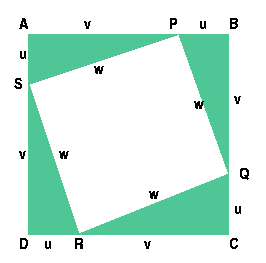| Page 2b | CIRCLE Menu | MAIN MENU |
| The Pythagorean Theorem states that the square of the length of the hypotenuse of any right triangle equals the sum of the squares of the lengths of the legs. |
| The action figure below gives a wonderful illustration of a geometric proof of the Pythagorean Theorem. |
| Experiment with the action figure below by sliding the small blue squares in the left hand figure along the axes. |
| Below is the algebraic explanation of how this figure shows that |
| In order to talk about the different parts of this figure, let's give some labels to the right-hand square of the action figure above. These labels are shown in Figure 1. |  | ||||||||||||||||||||||||||||||||
Consider this square, ABCD, with side lengths |
We see that <APB, <BQC, <CRD and <DSA are straight angles. That is, they measure 180o. We want to show that <SPQ, <PQR, <QRS and <RSP are each right angles in order to show that the interiour quadrilateral, PQRS, is a square.
| (By construction, we already know all four sides of this quadrilateral have the same length, w.)
Notice that |
Thus | This implies that
In the same way we can show that |
Now we compute the area of ABCD in two ways to finally show that |
|
|
Because the area of ABCD computed by either method must be the same, we can equate these two expressions and arrive at :
| ==> | |||||||||||||||||||||||||